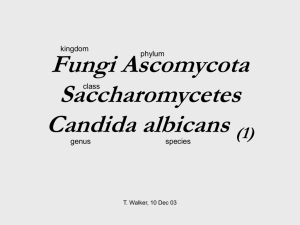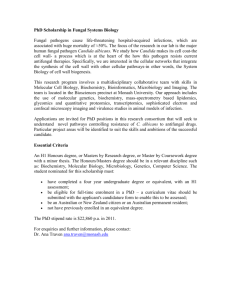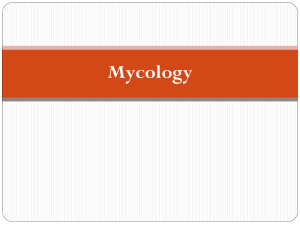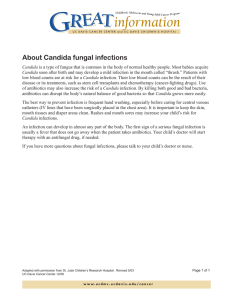Document 13309065
advertisement
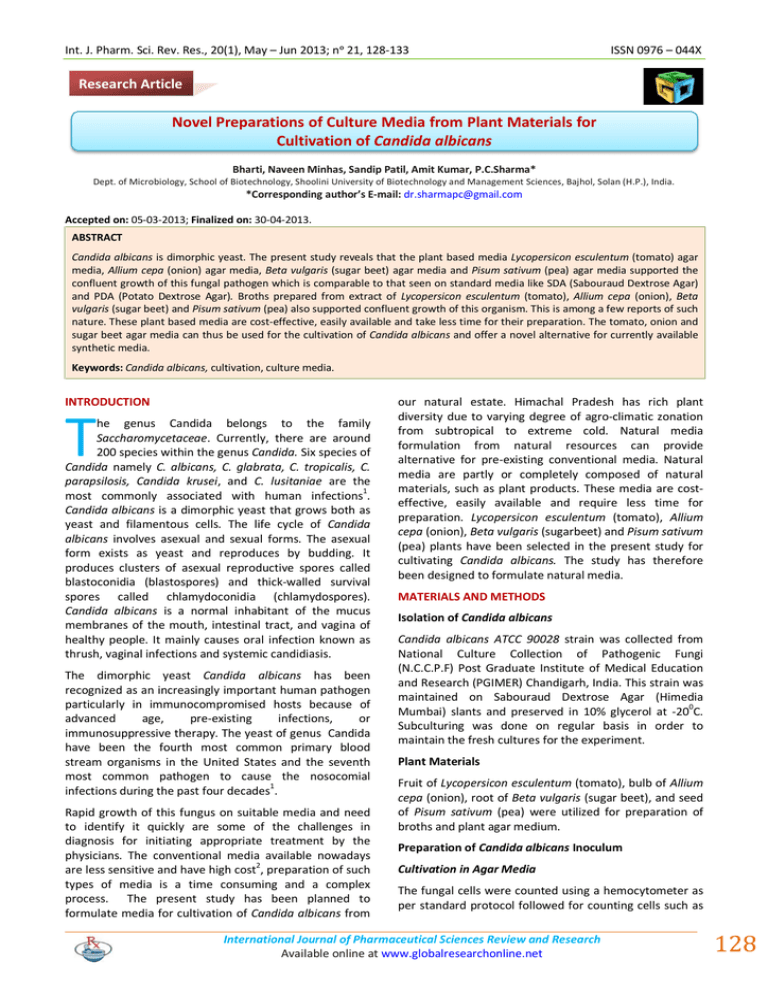
Int. J. Pharm. Sci. Rev. Res., 20(1), May – Jun 2013; nᵒ 21, 128-133 ISSN 0976 – 044X Research Article Novel Preparations of Culture Media from Plant Materials for Cultivation of Candida albicans Bharti, Naveen Minhas, Sandip Patil, Amit Kumar, P.C.Sharma* Dept. of Microbiology, School of Biotechnology, Shoolini University of Biotechnology and Management Sciences, Bajhol, Solan (H.P.), India. *Corresponding author’s E-mail: dr.sharmapc@gmail.com Accepted on: 05-03-2013; Finalized on: 30-04-2013. ABSTRACT Candida albicans is dimorphic yeast. The present study reveals that the plant based media Lycopersicon esculentum (tomato) agar media, Allium cepa (onion) agar media, Beta vulgaris (sugar beet) agar media and Pisum sativum (pea) agar media supported the confluent growth of this fungal pathogen which is comparable to that seen on standard media like SDA (Sabouraud Dextrose Agar) and PDA (Potato Dextrose Agar). Broths prepared from extract of Lycopersicon esculentum (tomato), Allium cepa (onion), Beta vulgaris (sugar beet) and Pisum sativum (pea) also supported confluent growth of this organism. This is among a few reports of such nature. These plant based media are cost-effective, easily available and take less time for their preparation. The tomato, onion and sugar beet agar media can thus be used for the cultivation of Candida albicans and offer a novel alternative for currently available synthetic media. Keywords: Candida albicans, cultivation, culture media. INTRODUCTION T he genus Candida belongs to the family Saccharomycetaceae. Currently, there are around 200 species within the genus Candida. Six species of Candida namely C. albicans, C. glabrata, C. tropicalis, C. parapsilosis, Candida krusei, and C. lusitaniae are the most commonly associated with human infections1. Candida albicans is a dimorphic yeast that grows both as yeast and filamentous cells. The life cycle of Candida albicans involves asexual and sexual forms. The asexual form exists as yeast and reproduces by budding. It produces clusters of asexual reproductive spores called blastoconidia (blastospores) and thick-walled survival spores called chlamydoconidia (chlamydospores). Candida albicans is a normal inhabitant of the mucus membranes of the mouth, intestinal tract, and vagina of healthy people. It mainly causes oral infection known as thrush, vaginal infections and systemic candidiasis. The dimorphic yeast Candida albicans has been recognized as an increasingly important human pathogen particularly in immunocompromised hosts because of advanced age, pre-existing infections, or immunosuppressive therapy. The yeast of genus Candida have been the fourth most common primary blood stream organisms in the United States and the seventh most common pathogen to cause the nosocomial infections during the past four decades1. Rapid growth of this fungus on suitable media and need to identify it quickly are some of the challenges in diagnosis for initiating appropriate treatment by the physicians. The conventional media available nowadays are less sensitive and have high cost2, preparation of such types of media is a time consuming and a complex process. The present study has been planned to formulate media for cultivation of Candida albicans from our natural estate. Himachal Pradesh has rich plant diversity due to varying degree of agro-climatic zonation from subtropical to extreme cold. Natural media formulation from natural resources can provide alternative for pre-existing conventional media. Natural media are partly or completely composed of natural materials, such as plant products. These media are costeffective, easily available and require less time for preparation. Lycopersicon esculentum (tomato), Allium cepa (onion), Beta vulgaris (sugarbeet) and Pisum sativum (pea) plants have been selected in the present study for cultivating Candida albicans. The study has therefore been designed to formulate natural media. MATERIALS AND METHODS Isolation of Candida albicans Candida albicans ATCC 90028 strain was collected from National Culture Collection of Pathogenic Fungi (N.C.C.P.F) Post Graduate Institute of Medical Education and Research (PGIMER) Chandigarh, India. This strain was maintained on Sabouraud Dextrose Agar (Himedia Mumbai) slants and preserved in 10% glycerol at -200C. Subculturing was done on regular basis in order to maintain the fresh cultures for the experiment. Plant Materials Fruit of Lycopersicon esculentum (tomato), bulb of Allium cepa (onion), root of Beta vulgaris (sugar beet), and seed of Pisum sativum (pea) were utilized for preparation of broths and plant agar medium. Preparation of Candida albicans Inoculum Cultivation in Agar Media The fungal cells were counted using a hemocytometer as per standard protocol followed for counting cells such as International Journal of Pharmaceutical Sciences Review and Research Available online at www.globalresearchonline.net 128 Int. J. Pharm. Sci. Rev. Res., 20(1), May – Jun 2013; nᵒ 21, 128-133 6 leucocytes. Inoculum containing 10 cfu/ml was prepared and inoculated in a volume of 10µl on each plant agar media and incubated at 250C for 24h, 48h and 72 h. Cultivation in Broth Media 6 Inoculum containing 10 cfu/ml of Candida albicans was prepared by using Mcfarland standard. Inoculum in a volume of 100µl was added to the each plant broth, incubated at 25°C for 24h, 48h and 72 h and the optical densities were measured at 600 nm at the specified time intervals. Preparation of Broths ISSN 0976 – 044X Test for Alkaloids ’ A few drops of Mayer s Reagent were added to 1ml of each plant extract. Development of yellow color indicated the presence of Alkaloids. Test for glycoside Few drops of ferric chloride & conc. H2SO4 were added to the solution of the extract in glacial acetic acid and observation of a reddish brown coloration at the junction of two layers and the bluish green color in the upper layer indicates glycoside. Test for Terpenoids Prepared plant extracts were sterilized in autoclave at 121°C for 15 minutes at 15lb pressure and 20ml volume of each extract were poured into sterile test tubes. 0.5 g plant extract were added in 2 ml of chloroform and 3 ml conc. H2SO4 was added carefully to form a layer. Appearance of reddish brown color at the interface indicates presence of terpenoids. Test for Steroids 0.5 g plant extract was added in 3 ml of chloroform, filter it and conc. H2SO4 was added carefully to form a layer. Presence of reddish brown color at the interface show positive results for the presence of steroids. Test for reducing sugars (a) (b) Figure 1: (a) Sugar beet, Pea and Onion broth (in triplicate in front row) (b) Tomato broth (right side in triplicate) compared with YPD and PDB (left side in duplicate). 0.5 ml of extract was added in 1 ml distilled water and 5-8 drops of Fehling A and B were added in equal amount at hot. Appearance of brick red precipitate indicates positive results for reducing sugars. Preparation of agar based media Test for Saponins For the preparation of these media, known amounts (1g, 2g and 5g) of powder of each plant material were added to 100ml of sterile distilled water in separate conical flasks and boiled for 10minutes with occasional shaking. The extracts were then filtered through muslin cloth for coarse residue and finally filtered through filter paper Whatman No.1 and the final volume adjusted to 100ml. 3g of Agar-Agar powder was then added to it, pH adjusted to 5.6-5.8, sterilized by autoclaving at 121°C for 15 minutes at 15lbs pressure. About 15-20ml of media was poured to sterile Petri dishes to a thickness of 4mm 2. 1 ml extract was poured in 1 ml of distilled water and shake it vigorously. Froth formation indicates presence of saponins. Spread plate method for inoculation of Candida albicans on plant agar Inoculum containing 96 cells of Candida albicans in 10 µl vol. was seeded over Tomato agar, Onion agar, Sugar beet agar, and Pea agar separately and spread with sterile L- shaped spreader. The plates were incubated at 30°C for 72 hours. The growth and characteristics of fungal colonies in the plates were recorded and colonies were counted in a colony counter. Phytochemical analyses of the plant extracts The extracts were analyzed for the presence of alkaloids, terpenoids, reducing sugars, saponins, tannins, flavonoids, steroids, proteins, coumarins, glycosides and 3-4 phenol . Test for Tannins Few drops of 10% lead acetate were added in 1 ml of extract. Occurrence of precipitate indicates presence of tannins. Test for Flavonoids 0.2g of plant extract was dissolved in Dil. Sodium hydroxide and Dil. Hydrochloric acid were added. Yellow solution turns colorless; it indicates the presence of flavonoids. Test for Coumarins 1ml ethanol – KOH solution was added in 1ml of extract and appearance of yellow precipitates indicates positive test for coumarins. Test for Phenols 1 ml of plant extract was taken in a test tube and 5 ml distilled water and few drops of neutral ferric chloride were added. Appearance of dark green color indicates positive test. International Journal of Pharmaceutical Sciences Review and Research Available online at www.globalresearchonline.net 129 Int. J. Pharm. Sci. Rev. Res., 20(1), May – Jun 2013; nᵒ 21, 128-133 Test for Proteins (Biuret Test) 3 ml of extract was taken and 4% NaOH and few drops of 1% CuSO4 solution were added. Appearance of violet or pink color indicates presence of proteins. Phytochemical constituents detected from different plant extracts are given in Table 2. HPLC analysis ISSN 0976 – 044X the growth of Candida albicans during 24-72 hrs. of incubation. Growth in these broths was comparable with that in the standard media. Maximum increase in O.D. values occurred after 24hrs and 48hrs of growth. The optical densities observed in case of Lycopersicon esculentum (tomato), Allium cepa (onion) and Beta vulgaris (sugar beet) increased much progressively than in case of Pisum sativum (pea). The samples were processed for analysis by reverse phase HPLC using mixed phosphate buffer as solvent. Table 1: Colony forming units (cfu) recovery of Candida albicans on Lycopersicon esculentum (tomato) agar after 72 hrs. of incubation. Concentration Cfu (Tomato) Cfu (Sugarbeet) Cfu (Onion) Cfu (Pea) 1gm 385 83 24 37 2gm 169 87 25 42 5gm 554 123 38 34 SDA 198 122 27 37 PDA 215 95 29 29 Table 2: Phytochemical Analysis for Prepared Plant Extracts. Tomato Sugarbeet Onion Pea Proteins _ _ _ _ Alkaloids _ _ _ _ Glycosides + + + + Terpenoids + + + + Steroids + + + _ Flavonois + + + + Saponins + + + + Reducing sugars _ _ _ _ Coumaris _ + + _ Phenols _ _ _ _ Tannins + + _ _ (a) (b) (c) Figure 2: (a) Tomato powder (b) Sugar beet powder (c) Onion powder Recovery of Candida albicans in Colony forming unit (Cfu) at 72 hrs of incubation are presented in Fig 3a, 3b 3c, 3d and in Table 1. The recovery of the organism is seen with all the measured amounts of plant material and this recovery was comparable with standard media used (SDA, PDA ) but the best recovery was observed in Tomato agar, Sugar beet agar and Onion agar at 5gm than at 2gm and 1gm concentration. The Cfu/ml in Tomato agar at 5gm was 554, at 2gm was 169 & at 1gm was 385. These values for Sugar beet agar were 123, 87 and 83 respectively at 5, 2 and 1 gm. + presence; _ absence RESULTS AND DISCUSSION The present study on the evaluation of plant extract broths of Lycopersicon esculentum (tomato), Allium cepa (onion), Beta vulgaris (sugar beet) and Pisum sativum (pea) for supporting the growth of C. albicans reveals that all the plant extract broths in all concentrations used i.e. 1%, 2% and 5% (w/v) support the growth of C. albicans during 72 hrs of incubation progressively. Optical density values of plant product broths inoculated with Candida albicans for Lycopersicon esculentum (tomato) is given in the Fig 4, for Allium cepa (onion) in Fig 5, for Beta vulgaris (sugar beet) in Fig 6, and for Pisum sativum (pea) in Fig 7. Growths in plant product broth were compared with growth in standard broths like PDB (Potato dextrose broth) and YPD (Yeast extract peptone dextrose). It is evident from the data that all the plant broths supported (a) (b) (c) (d) Figure 3: (a) Creamish white colored colonies of Candida albicans in (a) Lycopersicon esculentum (tomato) agar medium (b) Beta vulgaris (sugarbeet) agar medium (c) Allium cepa (onion) agar medium (d) Pisum sativum (pea) agar medium after 72 hrs of incubation. International Journal of Pharmaceutical Sciences Review and Research Available online at www.globalresearchonline.net 130 Int. J. Pharm. Sci. Rev. Res., 20(1), May – Jun 2013; nᵒ 21, 128-133 2.5 1.6 optical density at 600nm ISSN 0976 – 044X 1.4 2 1.2 1 0hr 0.8 0.6 24hrs 0.4 48hrs 0.2 72hrs 0 1.5 0 hr 24 hrs 1 48hrs 72hrs 0.5 1g 2g 5g 0 concentration tomato powder 1g Figure 4: The optical density values of Lycopersicon esculentum (tomato) broth at conc. of 1%, 2% and 5% (w/v) after 24, 48 and 72 hrs of incubation at 600 nm. The values are expressed as mean and S.D (n=3). optical density at 600nm 2.5 2 1.5 0 hr 24 hrs 1 48hrs 0.5 72hrs 0 1g 2g 5g concentration of onion powder Figure 5: The optical density values of Allium cepa (onion) broth at conc. of 1%, 2% and 5% (w/v) after 24, 48 and 72 hrs of incubation at 600 nm. The values are expressed as mean and S.D (n=3). optical density at 600 nm 1.2 1 0.8 0 hr 0.6 24 hrs 0.4 48hrs 0.2 72hrs 0 1g 2g 5g Concentration of sugarbeet powder Figure 6: The optical density values of Beta vulgaris (sugarbeet) broth at conc. of 1%, 2% and 5% (w/v) after 24, 48 and 72 hrs of incubation at 600 nm. The values are expressed as mean and S.D (n=3). 2g 5g Figure 7: The optical density values of Pisum sativum (pea) broth at conc. of 1%, 2% and 5% (w/v) after 24, 48 and 72 hrs of incubation at 600 nm. The values are expressed as mean and S.D (n=3). Moreover, this is an important observation in the direction of using such media for growing Candida albicans as a replacement for synthetic media such as Sabouraud Dextrose Broth (SDB), Brain-Heart Infusion (BHI), Buffered Yeast Nitrogen Base (BYNB), RPMI1605-7, which are complex and expensive. Further studies are required to be done in this regard before arriving at definite conclusion. These plant based media can be assessed for chlamydospore formation by Candida spp. and also for the growth of other microorganisms. Such media can also be assessed for the growth of commercially important microbes. In contrast to above possibilities, higher concentration of plant extracts can be evaluated for the growth of microorganisms. Further effect of temperature and pH parameters on these media can also be critically determined for optimum growth. The plant extract agar material from all the plants used in this study has been used as differential medium by various workers8-12. Plant based media such as henna leaf based media, mustard seed based media and smoke tree leaf based media have been found to be supporting the confluent growth of Cryptococcus neoformans, which makes them a good option as selective media for 13 Cryptococcus neoformans . Tomato juice agar, a well known medium employed to observe ascosporic formation, with niger seed agar, casein agar and sunflower seed agar, applied to a differentiation between C. dubliniensis and C.albicans14. But similar studies regarding the plant based broth media supporting the growth of Candida albicans have not been reported. This is perhaps the first study which reports the use of plant based broth media supporting confluent growth of Candida albicans individually without any supplementation. Various culture media including both synthetic and natural are tested as differential and selective media for the isolation and presumptive identification of Candida albicans from environmental and clinical samples15. International Journal of Pharmaceutical Sciences Review and Research Available online at www.globalresearchonline.net 131 Int. J. Pharm. Sci. Rev. Res., 20(1), May – Jun 2013; nᵒ 21, 128-133 Sabouraud dextrose agar (SDA) which is standard medium for maintenance of fungi has been supplemented with antibiotics. CHROM agar medium is a widely used medium for the identification of Candida spp. as colonies on this medium develop with distinguishable colors. This medium allows the presumptive identification of C. albicans, C. tropicalis, and C. krusei. In this study, four plant based media were tested for Candida albicans. Plant decoctions were made by boiling the powder at three concentrations i.e. 1%, 2% and 5% (w/v) in distilled water and were used to prepare agar plates. Each plant based media was inoculated with Candida albicans and observed after 72 hrs for the growth and colony characteristics. ISSN 0976 – 044X be mentioned that above results were confirmed after spiking of samples. It is likely that this compound may be contributing in the confluent growth of the Candida albicans. Further studies are however, required to be conducted in order to arrive at definitive conclusion. Peaks with retention time of 2.538 and 2.831 were also observed in the samples of onion and sugar beet respectively. The compounds giving such peaks can be analyzed by comparing with appropriate standards. Such compounds could also be supporting the growth of this fungus. Further studies are however required to establish such assumption. Lycopersicon esculentum (tomato) based medium was light pale in color and showed heavy growth after 72 hrs at all the three concentrations but the effect was progressively increase with higher concentration. Maximum increase in O.D. value occurred after 24hrs or 72hrs of incubation. Therefore, this media could be used for the growth of Candida albicans as reported by others812 . Allium cepa (onion) based medium was translucent and light pink in color and showed good and countable growth after 72 hrs at all the three concentrations and the effect was progressive with increase with higher concentration. Maximum increase in O.D. value occurred after 24hrs or 72hrs of incubation. So, this media also seems to be better alternative for Candida albicans as compared to other plant based media11-12. Figure 8a: Analysis of tomato sample by HPLC (peak corresponding to the standard Lycopene (b) is visible. Beta vulgaris (sugar beet) based medium was dark brown in color and showed heavy growth of Candida albicans after 72 hrs at all the three concentrations. The colonies were creamish white in color and small in size as compared to colonies that appeared on SDA and PDA. Pisum sativum (pea) based medium was light green in color. Colonies on this media appeared after 72 hrs. Also this medium seems to be less supportive at lower concentration as the best growth in terms of optical density was observed at 5gm and the Cfu/ml count was also found to be greater at 5gm than with 2gm and 1gm concentrations. The Cfu/ml count was corroborated by growth in higher conc. of broth and also the fact that the count increased with increasing concentration. All plant based media were compared with standard media like SDA and PDA. Growth on plant agar media were almost comparable with standard media in terms of Cfu/ml, but colony size on standard media was found to be greater than that observed on plant agar media. HPLC analysis The peak corresponding to standard compound, lycopene was obtained in the samples of Lycopersicon esculentum (tomato). The Chromatograms are presented in the Fig 8a and Fig 8b. Such peak was not observed in case of onion and sugar beet. However, sample of garden peas (Pisum sativum) could not be analyzed by this technique. It may Figure 8b: Analysis of standard compound Lycopene by HPLC. CONCLUSION It can be concluded from the present study that all plant based media are found to be supporting the confluent growth of Candida albicans. Thus, these plant based media are selective and economical and simple to prepare, therefore, offer a novel alternative for currently available synthetic media. Acknowledgements: Authors are thankful to the Vice Chancellor, Dr. P.K. Khosla, Shoolini University of Biotechnology and Management Sciences for providing necessary facilities and support to carry out this work. International Journal of Pharmaceutical Sciences Review and Research Available online at www.globalresearchonline.net 132 Int. J. Pharm. Sci. Rev. Res., 20(1), May – Jun 2013; nᵒ 21, 128-133 REFERENCES 1. Chander J, Textbook of Medical Mycology, Mehta, Edn 3, 2009, 266-283. 2. Nandhakumar B, Menon T, Kumar Girish CP, A new hennabased medium for the differentiation of Cryptococcus neoformans, J. Clinical Microbiol., 56, 2007, 568. 3. Adetuyi AO, Popoola AV, Extraction and dyes ability potential studies of the colourant in zanthoxylum zanthoxyloides plant on cotton fabric, Journal of Science Engineering Technology, 8(2), 2001, 3291-3299. 4. Sofowora A, Medicinal plants and Traditional medicine in West Africa, John wiley and sons, 1982, pp. 256, New York. 5. Koneman EW, Roberts GDP, Practical Laboratory Mycology, Baltimore, Williams and Wilkins, Edn 3, 1985, 1-211. 6. McGinnis MR, Laboratory Handbook of Medical Mycology, New York Academic Press, Edn 3, 1980, 248-251. 7. Roberts GC, Goodman NL, Land GA, Larsh HW, McGinnis MR, Manual of Clinical Microbiology, Edn 4, 1985, 500-513. 8. Hopfer RL, Blank F, Caffeic acid-containing medium for identification of Cryptococcus neoformans, J. Clin. Microbiol., 2, 1975, 115–120. 9. Chaskes S, Tyndall RL, Pigment production of Cryptococcus neoformans and Cryptococcus species from aminophenols and diaminobenzenes, J. Clin. Microbiol., 7, 1978, 146–152. ISSN 0976 – 044X 10. Denning DW, Stevens DA, Hamilton JR, Comparison of Guizotia abyssinica seed extract (Birdseed) agar with conventional media for selective identification of Cryptococcus neoformans in patients with acquired immunodeficiency syndrome, J. Clin. Microbiol., 28, 1990, 2565–2567. 11. Khan ZU, Ahmad S, Mokaddas E, Chandy R, Simplified sunflower seed agar for differentiation of Candida dubliniensis from Candida albicans, Clin. Microbiol. Infect., 10, 2004, 590–592. 12. Nandhakumar B, Girish Kumar CP, Prabu D, Menon T, Mustard seed agar – a new medium for differentiation of Cryptococcus neoformans, J. Clin Microbiol., 44, 2006, 674. 13. Pant N, Sharma PC, Jatana M, Amit K, Patil S and Sunity Singh, A novel modification of culture media for cultivation of Cryptococcus neoformans by using different extracts of different plants from Solan area of Himachal Pradesh (India), Elixir Bio Tech., 45, 2012, 7876-7880. 14. Alves, Loreto SH, Linares ES, Silveira CE, Scheid CP, Pereira LA, DIB & Santurio JM, Comparison among tomato juice agar with other three media for differentiation of Candida dubliniensis from Candida albicans, Rev. Inst. Med. trop. S. Paulo, 48 (3), 2006, 119-121. 15. Fleming WH, Hopkins JM and Land GM, J. Of Clin Microbiol., 5, 1977, 236-243. Source of Support: Nil, Conflict of Interest: None. International Journal of Pharmaceutical Sciences Review and Research Available online at www.globalresearchonline.net 133

